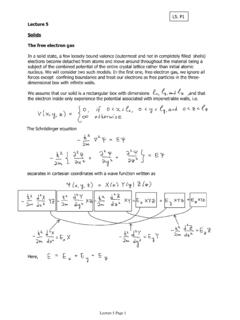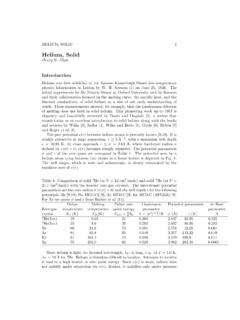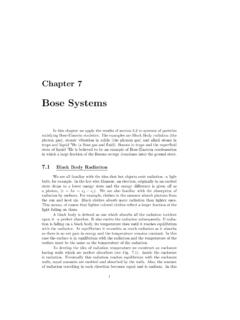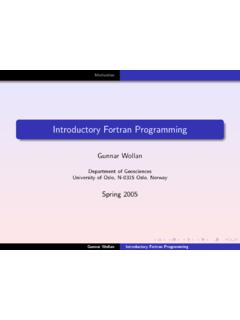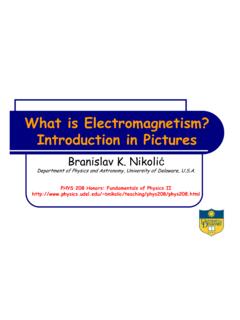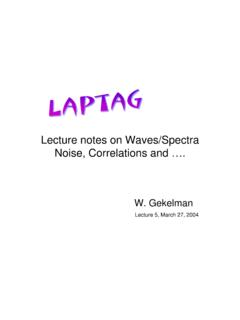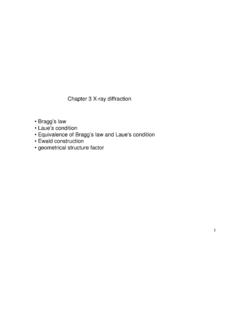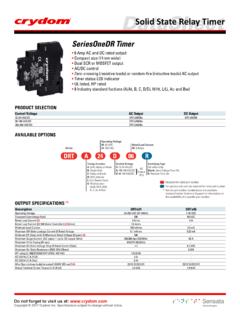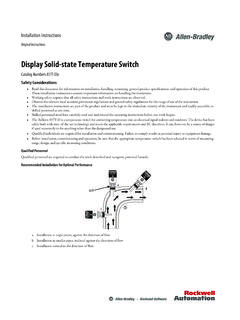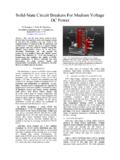Transcription of Condensed Matter Systems - Delaware Physics
1 What is solid State Physics ? Branislav K. Nikoli . Department of Physics and Astronomy, University of Delaware , PHYS 624: Introduction to solid State Physics ~bnikolic/teaching/phys624 Condensed Matter Systems Hard Matter Soft Matter Colloidal Polymer Dispersions Melts and Crystalline Solids Non-Crystalline Solutions (Metals, Insulators, Solids Semiconductors) Liquid Crystals Crystalline Solids + Quasicrystals Amorphous Biomatter Defects Solids (Glass) (proteins, (point, membranes, dislocations, Polymer nucleic acids). surfaces and Solids (Glass interfaces). and Rubber). PHYS 624: Introduction to solid State Physics Basic Notions of Condensed Matter Quasiparticles excitations which look nearly as individual particles as possible - modern Condensed Matter theory asserts that a solid crystal is actually a gas of weakly interacting quasiparticles.
2 Scalar Bosons (Spin=0). Broken symmetry, long-range order, and order parameters . Phases of Matter are characterized by the symmetry of their ground (lowest energy) state (Landau, 1937). Phase Transitions between different broken symmetry states : Classical (at T>0) and Quantum (at T=0). PHYS 624: Introduction to solid State Physics Quasiparticles vs Collective Excitations Electron: a quasiparticle e Phonon: This is a collective excitation, corresponding to consisting of a real coherent motion of all the atoms electron and the cloud of in the solid . It is quantized effective charge of opposite sign due to qe lattice vibration with a typical energy scale exchange an correlation effects arising interaction Exciton: bound state of electron with all other electrons in and hole with binding energy10eV.
3 The system . The electron is a fermion with spin . The Plasmon: longitudinal charge Fermi energy (highest oscillations of the entire electron occupied state) is of the gas relative to the lattice of ions order of 5 eV and the due to the long-range nature of the Fermi velocity is 108 cm/s, Coulomb interaction so it can be treated like a nonrelativistic particle. The mass of quasiparticle can Magnon: be substantially different Polaron: a quasiparticle, like electron, whose motion collective than that of the free in polar crystals distorts the lattice of positive and excitation of electron. negative ions around it polaron has different mass the spin than the electron.
4 Degrees of freedom on the Hole: a quasiparticle, like the electron, but of opposite charge; it corresponds to the absence crystalline of electron for a single-particle state which lies below the Fermi level. The notion of a hole is lattice with an particularly convenient when the reference state consists of a quasiparticle states that are energy scale fully occupied and are separated by an energy gap from the unoccupied state. PHYS 624: Introduction to solid State Physics Experimental Probes of Condensed Matter Phases and Quasiparticle Dynamics Scattering: Send neutrons or X-rays into the system with prescribed energy and momentum; measure the energy and momentum of the outgoing neutrons or X-rays.
5 NMR: Apply static magnetic field B and measure absorption and emission of magnetic radiation at frequencies of the order geB. of c = . m Thermodynamics: Measure the response of macroscopic variables (energy, volume, etc.) to variations of the temperature, pressure, etc. Transport: Set up a potential or thermal gradient T and measure the electrical or heat current. The gradients can be held constant or made to oscillate at finite frequency. PHYS 624: Introduction to solid State Physics Quantum Hamiltonian of Condensed Matter Physics The general theory of quantum mechanics is now almost complete. The underlying physical laws necessary for the mathematical theory of a large part of Physics and the whole of chemistry are thus completely known, and the difficulty is only that the exact application of these laws leads to equations much too complicated to be soluble.
6 P. A. M. Dirac 1929. 2 NN. 2 NN. P e Zn Zm Quantization H= . n + . n=1 2M 2 n m=1 | Rn Rm | p i , P i . n r R. TN : motion of nuclei VN N : interaction between nuclei Ne pi2 e2 Ne 1 NN Ne Zn + . i =1 2Mi + . 2 i j =1 | ri rj |. e . 2. n=1 i =1 | Rn ri |.. Te : motion of electrons Ve e :int eraction between electrons Ve N :interaction between electrons and nuclei PHYS 624: Introduction to solid State Physics Complexity in solid State Hamiltonian Even for chemist, the task of solving the Schr dinger equation for modest multi- electron atoms proves insurmountable without bold approximations. The problem facing Condensed Matter physicist is qualitatively more severe: 23.
7 N N Ne 10. 2. Energy scales: 10 eV 10 eV 4. CM Theorist is entrapped in the thermodynamic limit . PHYS 624: Introduction to solid State Physics The Way Out: Separate Length and Energy Scales Energy: , T < 1 e V.. Time: 19. 1 0 15. s 1eV 10 J. Length: | x i x j |, q 1 1 . forget about atom formation + forget about crystal formation me + Born-Oppenheimer approximation for 1. mN.. H electronic =T e +V e I +V e e, V e I (r +rn) =V e I (r), rn = n1a1 +n2a2 +n3a3. PHYS 624: Introduction to solid State Physics Non-Interacting Electrons in Solids: Band Structure Calculations In band structure calculations electron-electron interaction is approximated in such a way that the resulting problem becomes an effective single-particle quantum mechanical problem.
8 H IE,H,LDA (r ) kIbE,H,LDA (r ) = IE,H,LDA (k , b ) kIE,H,LDA. b (r ). H electronic = T e + V e I + V e e N e H IE = T e + V e I = H IE (ri ). i =1. n(r ). H Hartree = Te + Ve I + e dr . 2. , n(r) = | kHb (r) |2 = n(r + rn ). | r r | H ( k ,b ) EF. n (r ) ELDA. xc [ne ]. HLDA = HIE (r) + e dr . 2. + , ExcLDA[ne ] = dr n(r)excLDA (n(r)). | r r | n(r). PHYS 624: Introduction to solid State Physics From Many-Body Problem to Density Functional Theory (and its LDA approximation). Classical Schr dinger equation approach: SE .. V (r ) (r1 , , rNe ) average of observables Example: Particle density n(r ) = N dr2 dr3 drN * (r, , rNe ) (r, , rNe ).
9 DFT approach (Kohn-Hohenberg): n0 (r ) 0 (r1 , , rNe ) V (r ). 0 (r1 , , rNe ) 0 [ n0 (r )]. PHYS 624: Introduction to solid State Physics Pauli Exclusion Principle for Atoms Without the exclusion principle all electrons would occupy the same atomic orbital. There would be no chemistry, no life! PHYS 624: Introduction to solid State Physics Many-Body Wave Function of Fermions It is with a heavy heart, I have decided that Fermi-Dirac, and not Einstein is the correct statistics, and I have decided to write a short note on paramagnetism. W. Pauli in a letter to Schr dinger (1925). All electrons in the Universe are identical two physical situations that.
10 Differ only by interchange of identical particles are indistinguishable! Pij ( x1 , , xi , , x j , , xn ) = Pij ( x1 , , x j , , xi , , xn ). P ij H = HP. A = P AP. ij ij P A = AP. ij .. + A , P is even S A P S = S , P A = . A , P is odd 1. P A = A , A = P .. N! . PHYS 624: Introduction to solid State Physics Pauli Exclusion Principle for Hartree- Fock or Kohn-Scham Quasiparticles There is no one fact in the physical world which has greater impact on the way things are, than the Pauli exclusion principle. I. Duck and E. C. G. Sudarshan, Pauli and the Spin-Statistics Theorem (World Scientific, Singapore, 1998). Two identical fermions cannot occupy the same quantum-mechanical state: H = h 1 + h 2 + + h N.
